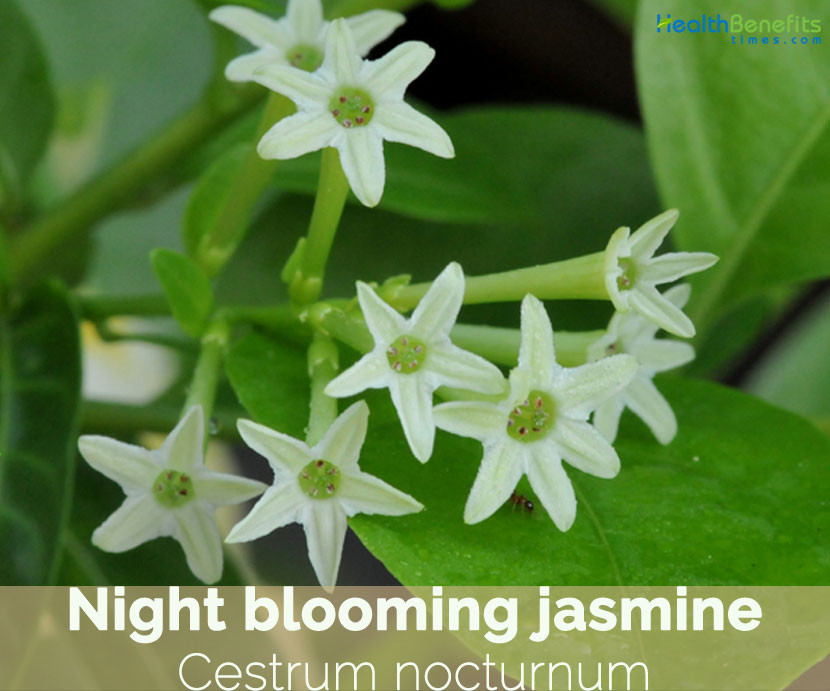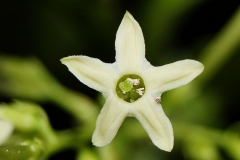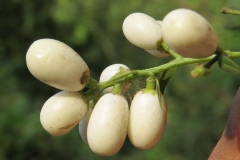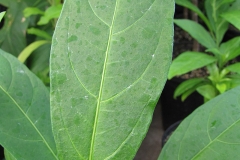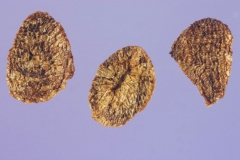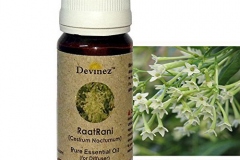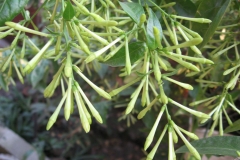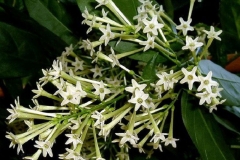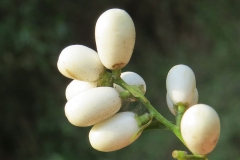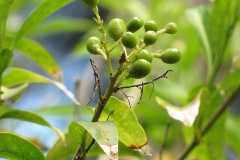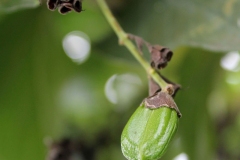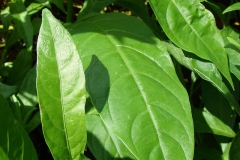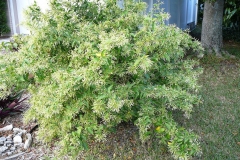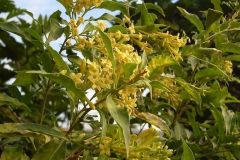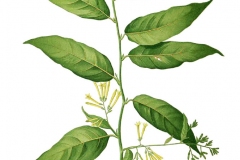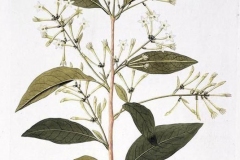| Night Blooming Jasmine Quick Facts | |
|---|---|
| Name: | Night Blooming Jasmine |
| Scientific Name: | Cestrum nocturnum |
| Origin | Mexico, Central America (i.e. Belize, Costa Rica, El Salvador, Guatemala, Honduras, Nicaragua and Panama) and Cuba |
| Colors | Initially green turning to white as they mature |
| Shapes | Small long oval to globular berries, hard or juicy, 8-10 mm in diameter |
| Taste | Bitter |
| Health benefits | Beneficial for epilepsy, other seizure disorders, headaches, nervous imbalances, skin eruptions, cataracts, malaria, night sweats, convulsions, |
| Name | Night blooming Jasmine |
|---|---|
| Scientific Name | Cestrum nocturnum |
| Native | Mexico, Central America (i.e. Belize, Costa Rica, El Salvador, Guatemala, Honduras, Nicaragua and Panama) and Cuba |
| Common Names | Evening scented jessamine, jessamine, lady of the night, lady-of-the-night, night blooming jasmine, night cestrum, night jessamine, night queen, night-blooming jasmine, night-flowering cestrum, night-flowering jasmine, night-scented jasmine, queen of the night. night blooming cestrum, bastard jasmine |
| Name in Other Languages | Arabic: Misk allayl (مسك الليل) Assamese: Hasna-hana Bengali: Hasna hana (হাসনাহেনা) Burmese: Nya-hmwe-pan, Saung-taw-ku Chamorro: Dama de noche, dama di noche Chinese: Ye xiang shu (夜香树),Ye xiang mu Cook Islands: Ariki-va’ine, tiare ariki va’ine Costa Rica: Zomillo Cuba: Galan de noche, Fedora, Jasmin de noche Dominican Republic: Jazmin de noche, rufiana El Salvador: Palo hediondo English: Lady-of-the-night, Night cestrum, Night flowering Jessamine, Night jasmine, Night Jessamine, Queen of the night, Night Jasmine, Night Queen, night-blooming jasmine, night-flowering cestrum, night-flowering jasmine, night scented cestrum, poison berry, Lady of the Night, Night-Blooming Jessamine, Dama de Noche, Galan de Noche, Night Blooming Cestrum Fijian: Kara, thauthau, thauthau ni mbongi, ai pua e pogi French: Jasmin de nuit, galant de nuit German: Nachtjasmin, Nacht- Hammerstrauch Greek: Nýchta giasemiá (νύχτα γιασεμιά) Guam: Dama di noche Guatemala: Galan de noche, Reina de la noche Haiti: Jasmin caca chatte, jasmin nuit, lilas de nuit Hawaiian: Ala aumoe, kūpaoa, onaona Iāpana Hindi: Raat ki Rani (रात की रानी) Indonesian: Arum dalu Italian: Galante de notte Japanese: Yakokwa Kongo: Dondoko Konkani: Raatrani (रातराणी) Latin: Nox Aenean virent Lukimi: Orufirin, Elube Malay: Sedap malam Malayalam: Niśāṟāṇi (നിശാറാണി) Mandarin: Ye xiang shu Manipuri: Thabai Lei ꯊꯥꯕꯜ ꯂꯩ Maori (Cook Islands): Ariki-va‘ine, tiare ariki va‘ine Marathi: Raatrani (रातराणी) Marshallese: Joñoul ruo awa Mexico : Huele de Noche, Heirba hedionda, Galan de Tarde Myanmar: Nya-hmwe-pan, saung-taw-ku Nepali: Hasana phool (हसना फूल) Nicaragua: Huele noche Niuean: Ike he po Oriya: ହେନା ଫୁଲ Persian: محبوبهشب Philippines: Dama de noche Polish: Noc kwitnący jaśmin Portuguese: Jasmim-da-noite, dama-da-noite Rotuman: Ai pua e pogi Samoan: Ali‘i o le pō, teine o le pō, ali’i o po Spanish: Dama de la noche, dama de noche, galán de noche, reina de la noche, huele de noche, palo hediondo Swedish: Vit nattjasmin Telugu: Rātri rāṇi (రాత్రి రాణి) Thai: Raatree, Rātrī (ราตรี) Tonga: Laukaupoʻuli Tuvaluan: Fafine o te po USA/Hawaii: Ala aumoe, kupaoa, onaona lapana Vietnamese: Dạ lý hương |
| Plant Growth Habit | Evergreen, upright and woody glabrous shrub or small tree |
| Growing Climates | Thrives in moist or wet forests including riparian zones, secondary forests and dense lowland forests, scrub, as well as open areas, both natural and disturbed, and is commonly cultivated in gardens, trail sides, forest gaps and landslides |
| Plant Size | About 2-4 m tall |
| Root | Grows best in well-draining, sandy soil, preferably somewhere with a lot of space for its roots to spread out |
| Twigs | Young twigs are sparsely finely hairy |
| Branches | Erect or drooping, angular, olive or bluish-green, lenticellate, glabrescent |
| Leaf | Simple, narrow lanceolate, 6–20 cm (2.4–7.9 in) long and 2–4.5 cm (0.79–1.77 in) broad, smooth and glossy, with an entire margin |
| Flowering season | May to November |
| Flower | Greenish-white, with a slender tubular corolla 2–2.5 cm (0.79–0.98 in) long with five acute lobes, 10–13 mm (0.39–0.51 in) diameter when open at night, and are produced in cymose inflorescences. A powerful, sweet perfume is released at night |
| Fruit Shape & Size | Small long oval to globular berries, hard or juicy, 8-10 mm in diameter containing 1-3-seeds |
| Fruit Color | Initially green turning to white as they mature |
| Propagation | Seeds, stem cuttings and air layering |
| Plant Parts Used | Leaves and Flowers |
| Seed | Seeds are ovoid, 2.5-6 mm long, black |
| Taste | Bitter |
| Culinary Uses |
|
Stems
The branches are somewhat flexuous (bending and twining) and are sparsely finely hairy (pubescent) with simple hairs. The smaller twigs especially, exhibit these hairs.
Leaves
The leaves are long, elliptical and lanceolate (resembling a spear-head), 6-15 cm long and 2-7 cm wide; smooth and glossy with even margins with petioles about 0.4-0.8 cm long. Lateral veins are curving inside the blade margin but not forming definite loops. The mid-rib under surface is finely hairy.
Flowers
The flowers are produced at the ends of the branches where they occur as dense clusters of flowers on short stems that arise from the junctions of the leaves and the twigs. The result is a densely crowded end cluster of both flowers and leaves. The flowers are tubular, greenish white to cream (there is a known yellow variety) and the top of the tube splits into five sharply pointed, triangular lobes or petals. Tubular section of the flower is 2-2.5 cm long and the opened flower at night is about 1-1.3 cm in diameter. The stamens and anthers are contained within the floral tube.
Although the flowers are not showy to the eye, their sweet scent can overpower. The perfume is distinctly powerful at night – this feature has had its influence on its common name in all languages. The Hindi name translates to queen of the night, while the Manipuri name means moon flower. No fragrant garden is complete without this nocturnal beauty. While night blooming jasmine is a gorgeous plant with charming blooms, the scent also produces severe allergic reactions in some individuals.
Fruit
Fertile flowers are followed by small long oval to globular berries, hard or juicy, 8-12 mm in diameter. These berries are initially green turning to white as they mature. The calyx stays fixed to the fruit. There may be up to 10 seeds in a single fruit and each seed is ovoid and about 4-5 mm long and 2-2.5 mm wide and are black colored.
Traditional uses and benefits of Night blooming jasmine
- Night jasmine have been used in traditional medicinal for topical application on burns, wounds and skin inflammation.
- Night jasmine can also help reduce swelling and inflammation in the joints due to arthritis.
- It is also been used as a treatment for relieving epilepsy symptoms.
- Night jasmine also has antiviral and antibacterial health benefits and has been used for infections like malaria.
- An extract of the plant is used as an antispasmodic and as a treatment for epilepsy.
- Decoction of the dried leaves were not effective against pharmacologically induced convulsions.
- Both aqueous and methanol extracts of the plant have shown bactericidal activity against Staphylococcus aureus and various other bacteria.
- In laboratory tests, extracts of the plant were shown to inhibit tumor growth.
- The Yucatec Maya place C. nocturnum leaves and flowers in hot baths as a treatment for night sweats.
- An extract of the leaves is used to treat epilepsy and other seizure disorders, as well as headaches and nervous imbalances in Mexican folk medicines.
- Leaf decoction is used as a lotion on skin eruptions in Central America and the Caribbean.
- In former times a fruit extract was taken orally as a sedative in cases of epilepsy, chorea and hysteria, the treatment being gradually reduced and terminated within a short time.
- Leaves are considered toxic to humans, but they may be used in small doses to treat epilepsy in Thailand.
- Leaves are used in Chinese folk medicine as an external application for burns and swellings.
- Extract of the plant are used as antispasmodic and treatment of epilepsy in Mexico.
- Fruits used for treatment of epilepsy in Antiles.
- Malasar people use its juice for cataracts in India.
- Yucatec Maya use flowers and leaves in hot bath treatments for ogjt sweats.
- Leaves are used for treating swelling and burns.
- Oil is used for treatment of malaria in Africa.
- It is used in the treatment of epilepsy, hysteria, nervousness and spasm.
Other facts
- Night blooming jasmine is a popular ornamental due to its showy and fragrant white flowers, and has for this reason been introduced around the world.
- It is also used as a hedge plant and cultivated as a medicinal plant.
- Leaves have an unpleasant odor when crushed.
- Night blooming jasmine can be grown in cooler climates as a house or conservatory plant.
- Night-blooming jasmines flower up to four times per year, after which, they produce white berries full of seeds.
- In Kathmandu, its flowers are presented as offerings to Shiva and Ganesh.
- Nepalese shamans create ritual incense from the leaves and fresh flowers, eat the fresh flowers, and smoke them when dried to increase spiritual healing energies.
- Fresh powdered leaves of Night blooming jasmine show promising control against the beetles rice weevil and Trogoderma granarium.
- Essential oil is used as mosquito repellent.
Prevention and Control
Due to the variable regulations around (de)registration of pesticides, your national list of registered pesticides or relevant authority should be consulted to determine which products are legally allowed for use in your country when considering chemical control. Pesticides should always be used in a lawful manner, consistent with the product’s label.
Physical/Mechanical control
Small plants and seedlings can be hand pulled all year round and left on site to rot down; since stems can re-sprout and re-infestation can occur through the seed bank, cleared sites should be replanted to prevent regrowth.
Chemical Control
Cutting and painting the cut surface with an herbicide solution can be done all year round. Kökeÿe Museum staff has reported good control of the species with triclopyr ester at 20% in crop oil applied to basal bark, and the species may be sensitive to foliar applications of triclopyr.
Precautions
- Berries are toxic to human and animals.
- Toxic symptoms are headache, dizziness, hallucinations, nausea, vomiting, bloody diarrhea, muscular spasms and nervousness, high temperature, salivation and sweating, paralysis and coma.
- Some people, especially those with respiratory sensitivities or asthma, have reported difficulty breathing, irritation of the nose and throat, headache, nausea, or other symptoms when exposed to the blossom’s powerful scent.
- Some plant describe C. nocturnum as “toxic” and warn that ingesting plant parts, especially fruit, may result in elevated temperature, rapid pulse, excess salivation and gastritis.
- Ingestion of green berries over several weeks by a 2-year-old child resulted in diarrhea, vomiting, and blood clots in the stool.
- It can cause respiratory irritation, headaches, rapid pulse, excess salivation, or other symptoms.
References:
https://www.itis.gov/servlet/SingleRpt/SingleRpt?search_topic=TSN&search_value=30498#null
http://www.hear.org/pier/species/cestrum_nocturnum.htm
https://www.cabi.org/isc/datasheet/12031
https://plants.usda.gov/core/profile?symbol=CENO
https://npgsweb.ars-grin.gov/gringlobal/taxonomydetail.aspx?id=9997
https://commons.wikimedia.org/wiki/Category:Cestrum_nocturnum
http://www.iucngisd.org/gisd/species.php?sc=851
https://davesgarden.com/guides/pf/go/2128/#b
https://gd.eppo.int/taxon/CEMNO
http://www.theplantlist.org/tpl1.1/record/kew-2713666
https://keyserver.lucidcentral.org/weeds/data/media/Html/cestrum_nocturnum.htm
https://indiabiodiversity.org/species/show/265827
http://www.flowersofindia.net/catalog/slides/Night%20Blooming%20Jasmine.html
https://en.wikipedia.org/wiki/Cestrum_nocturnum
http://tropical.theferns.info/viewtropical.php?id=Cestrum+nocturnum
https://uses.plantnet-project.org/en/Cestrum_nocturnum_(PROSEA)


